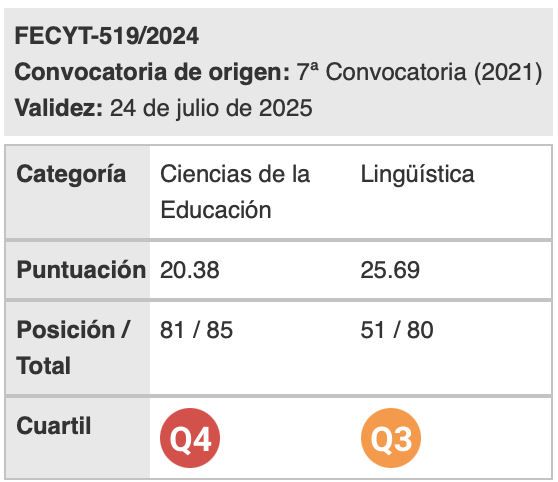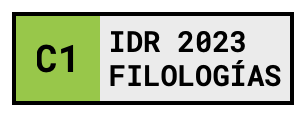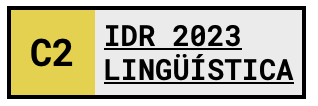Assessment in Spanish heritage language programs
Palabras clave:
evaluación, proficiencia de la lengua, narrativas personalesResumen
Spanish heritage language learners (HLLs) are heterogeneous in nature. Thus, how can we assess these students? Most of the literature on this has been on placement exams (Polinsky & Kagan, 2017, among others), but the focus of this article is on assessment in Spanish heritage courses. Placement test results should be indicators of what should be included in the curriculum. One of the main challenges is the lack of the following components: specific proficiency indicators for HLLs, consensus in defining key concepts, understanding dialect variation, assessment for measuring linguistic skills, and finally research on HLLs’ assessment (Malone, Kreeft Peyton, & Kim, 2014). Thus, assessment is the biggest challenge in HL education due to the dominant monolingual ideologies, so formative assessment practices are recommended to confront them by allowing HLLs to negotiate their linguistic identities via multilingual perspectives (King, Liu, & Schwedhelm, 2018). What are specific tools or activities to negotiate these? Personal narratives of US Latinos were collected by Carreira and Beeman (2014) for the sake of reflections of HLLs as language brokers. González-Davies (2004, 2018) also mentions the importance of peer-to-peer strategies for translation competence. These projects can also become group projects, like the manifestos implemented by Moreno and MacGregor-Mendoza (2019) in a course in which language, culture, and community are the goals. All these activities are examples of the kinds of assessment that may be effective in the heritage classroom and may guide their instructors. The goal of this article is to suggest activities to connect HLLs with their communities at the same time that their learning gains are assessed in terms of language proficiency.
Descargas
Citas
Beaudrie, S. (2016). Advances in Spanish heritage language assessment: Research and instructional
considerations. In Pascual y Cabo, D. (Ed.), Advances in Spanish as a heritage language, (pp. 143-158). John Benjamins.
Beaudrie, S. (2018). On the relationship between self-concept and literacy development in the Spanish
heritage language context. Reading & Writing Quarterly, 34(2), 147-159.
Beaudrie, S., Ducar, C, & Potowski, K. (2014). Heritage language teaching: Research and practice:
Columbus, OH: McGraw-Hill Education.
Beaudrie, S., Ducar, C., & Relaño-Pastor, A. (2009). Curricular perspectives in the heritage language
context: Assessing culture and identity. Language, Culture and Curriculum, 22, 157-174.
Belpoliti, F., & Gironzetti, E. (2017). Metaknowledge and metalinguistic strategies in the Spanish for
heritage learners classroom: a curriculum redesign. Hispanic Studies Review, 2(1), 45-72.
Brownlow, G. (2013). The Effects of Supplementary Reading Activities for Spanish Heritage Learners.
Retrieved from Sophia, the St. Catherine University repository website:
http://sophia.stkate.edu/cgi/viewcontent.cgi?article=1024&context=maed.
Carless, D. (2012). From testing to productive student learning: Implementing formative assessment in
Confucian- heritage settings. New York: Routledge.
Carreira, M. (2012). Formative assessment in HL teaching: purposes, procedures, and practices.
Heritage Language Journal, 9(1), 100-120.
Carreira, M. (2013). Advanced proficiency: A practitioner’s perspective on this special issue. Heritage
Language Journal, 10(2), 139-152.
Carreira, M. (2014). Teaching heritage language learners: A study of programme profiles, practices
and needs. In Trifonas, P.P., Aravossitas, T. (Eds.), Rethinking Heritage Language Education
(pp.20-44). Cambridge, UK: Cambridge University Press.
Carreira, M., & Beeman, T. (2014). Voces: Latino Students on Life in the United States. Santa Barbara,
CA: Praeger.
Carreira, M., & Kagan, O. (2011). Results of the National Heritage Language Survey: Implications for
teaching, curriculum design, and professional development. Foreign Language Annals, 44, 40–64. doi:10.1111/j.1944- 9720.2010.01118.x
Carreira, M., Hitchins Chik, C., & Karapetian, S. (2019). Project-based learning in the context of
teaching heritage language learners. In Gras-Velazquez, A. (Ed.), Project-Based Learning in Second Language Acquisition: Building Communities of Practice in Higher Education (pp. 135- 152). New York, NY: Routledge.
DuBord, E., & Kimball, E. (2016). Cross-language community engagement: Assessing the strengths of
heritage learners. Heritage Language Journal, 13(3), 298- 330.
Elola, I. (2017). Writing in Spanish as a second and heritage language: Past, present, and future.
Hispania, 100(5), 119-124.
Faltis, C. J. (1984). Reading and writing in Spanish for bilingual college students: What's taught at
school and what's used in the community. Bilingual Review / La Revista Bilingüe, 11(1), 21-32.
Foulis, E., & Barajas, J. (2019). Weaving our histories: Latin@ ethnography in the heritage language
classroom. Journal of Folklore and Education, 6, 98- 107.
García, O. (2009). Bilingual Education in the 21st Century: A Global Perspective. Chichester: John
Wiley & Sons.
Gómez-Pereira, D. (2018). Developing academic writing and cultural identity for Spanish heritage
language learners (HLLs) through writing texts in Spanish. (Doctoral Dissertation). Retrieved from Proquest Dissertation Publishing.
González-Davies, M. (2004). Multiple Voices in the Translation Classroom: Activities, Tasks, and
Projects. Amsterdam, Netherlands: John Benjamins.
González-Davies, M. (2018). The use of translation in an integrated plurilingual approach to language
learning: Teacher strategies and best practices. Journal of Spanish Language Teaching, 4(2), 1-12.
Grabe, W. (2009). Teaching and testing reading comprehension. In M. Long & C. Doughty (Eds.),
Handbook of second and foreign language teaching (pp. 441–462). Malden, MA: Blackwell.
Henshaw, F. (2016). Online courses for heritage learners: Best practices and lessons learners. In
Pascual y Cabo, D. (Ed.), Advances in Spanish as a heritage language, (pp. 281-298). John Benjamins.
Hislope, K. (2003). A reading study of Spanish heritage speakers. The Reading Matrix, 3(2), 1-21.
Howard, J. (2001). Service-learning course design workbook (Michigan Journal of Community Service
Learning, Companion Volume). University of Michigan: OCSL Press.
Kagan, O., & Dillon, K. (2009). The professional development of teachers of heritage language
learners: A matrix. In M. Anderson & A. Lazaraton (Eds.), Bridging context, making connec- tions: Selected papers from the fifth international conference on language teacher education (pp. 155–175). Minneapolis, MN: Center for Advanced Research on Language Acquisition.
Kagan, O., & Kudyma, A. (2019). Assessment and curriculum for heritage language learners:
Exploring Russian data. In P. Winke, S. M. Gass (eds.), Foreign Language Proficiency in Higher
Education, Educational Linguistics 37, (pp. 71-92). Springer Nature Switzerland AG.
Karahisarlidis, C., & Young, A. (2017). Spanish oral language proficiency assessments and two-way
immersion heritage language learners: Multimodal language analysis. Hispanic Studies Review, 2(1), 73-85.
King, K.A., Liu, M., & Schwedhelm, M.C. (2018). Language policy, language study, and heritage
language education in the US. In A. Bonnet & P. Siemund (Eds.), Foreign Language Education in Multilingual Settings (pp. 77-98). John Benjamins.
Lear, D., & Abbott, A. (2009). Aligning expectations for mutually beneficial community service-
learning: The case of Spanish language proficiency, cultural knowledge, and professional skills. Hispania, 92, 312-323.
Loureiro-Rodríguez, V. (2013). Meaningful writing in the heritage language class: A case study of
heritage learners of Spanish in Canada. L2 Journal, 5(1), 43-58.
Lucero, A. (2016). Oral narrative retelling among emergent bilinguals in a dual language immersion
program. International Journal of Bilingual Education and Biligualism, DOI: 10.1080/13670050.2016.1165181
Luo, H., Li, Y., & Li, M.Y. (2019). Heritage language education in the United States: A national
survey of college‐level Chinese language programs. Foreign Language Annals, 52(1), 101-120.
Malone, M.E., Kreeft Peyton, J., Kim, K. (2014). Assessment of heritage language learners: Issues and
directions. In T. G. Wiley, J. Kreeft Peyton, D. Christian, S. C. K. Moore, & N. Liu (Eds.), Handbook of Heritage, Community, and Native American Languages in the United States Research, Policy, and Educational Practice, (pp. 349-358). New York: Routledge.
Martin, C., Swender, E., & Rivera-Martinez, M. (2013). Assessing the oral proficiency of heritage
speakers according to the “ACTFL Proficiency Guidelines 2012- Speaking.” Heritage Language Journal, 10(2), 73-87.
Martínez, G. & San Martín, K. (2018). Language and power in a medical Spanish for heritage learners
program: A learning by design perspective. In G. C. Zapata & M. Lacorte (Eds.), Multiliteracies Pedagogy and Language Learning: Teaching Spanish to Heritage Speakers (pp. 107-128). New York, NY: Palgrave Macmillan.
Mellinger, C., & Gasca Jiménez, L. (2019). Challenges and opportunities for heritage language
learners in interpreting courses in the U.S. context/ Retos y oportunidades para hablantes de lenguas de herencia en cursos de interpretación en el contexto estadounidense. Revista Signos. Estudios de Lingüística, 52(101), 950-974.
Mercado, C.I. (2000). Monitoring the progress of heritage language learners: Assessment trends and
emerging practices. In J.B. Webb & B.L. Miller (Eds.), Teaching heritage language learners: Voices from the classroom (pp. 209-230). Yonkers, NJ: American Council on the Teaching of Foreign Languages.
Mikulski, A., & Elola, I. (2011). Spanish heritage language learners’ allocation of time to writing
processes in English and Spanish. Hispania, 94(4), 715–733.
Minor, D. (2017). Language instruction in the expanding borderlands teaching heritage language
learners enrolled in L2 classrooms. The Journal of the Midwest Modern Language Association, 50(2), 149-179.
Moreno, G., & MacGregor-Mendoza, P. (2019). Language, culture, and service: Innovative strategies
for bridging SHL classrooms and communities through service-learning. In G. Thompson, & S.M. Alvord (Eds.), Contact, Community, and Connections: Current Approaches to Spanish in Multilingual Populations (pp. 277-304). Wilmington, DL: Vernon Press.
Nick, G. (2012). Hindi heritage language learners’ performance during OPIs. Characteristics and
pedagogical implications. Heritage Language Journal, 9(2), 18-36.
Oh, J., & Au, T. (2005). Learning Spanish as a heritage language: The role of sociocultural background
variables. Language, Culture and Curriculum, 18(3), 229-241. DOI:10.1080/07908310508668744
Petrovic, I. (2018). Croatian as a heritage language in Canada. Zbornik Radova Filozofskog Fakulteta u
Splitu, 11, 59-72.
Poehner, M. E. (2008). Dynamic assessment: A Vygotskian approach to understanding and promoting
second language development. Berlin: Springer.
Polinsky, M., & Kagan, O. (2007). Heritage languages: In the ‘wild’ and in the classroom. Compass of
Language and Linguistics, 1(5), 368–395.
Potowski, K. (2005). Fundamentos de la enseñanza del español a hispanohablantes en los EE.UU.
Madrid: Arco Libros.
Reznicek-Parrado, L.M. (2014). The personal essay and academic writing proficiency in Spanish
heritage language development. Arizona Working Papers in SLA & Teaching, 71-83.
Rodrigo, V. (2012). Situación lingüística de los hablantes de herencia en Estados Unidos y la mejora
de su competencia en español. In B. Blecua, S.Borrell, B. Crous & F.Sierra. (Eds.),
Multilingüismo y enseñanza de ELE en contextos multiculturales. (pp. 135-142). University of
Girona Press.
Rose, D., & Martin, J. R. (2012). Learning to Write, Reading to Learn: genre, knowledge and
pedagogy in the Sydney school. United Kingdom Equinox.
Ruggiero, D.M. (2017). The CruCES project: A consideration of service learning and intercultural
sensitivity among heritage learners. Revista de Lenguas para Fines Específicos, 23(1), 45-62.
Schleppegrell, M. (2006). The linguistic features of advanced language use: the grammar of
exposition. In H. Byrnes (Ed.), Advanced Language Learning: The contribution of Halliday and Vygotsky (pp. 134-146). London and New York: Continuum.
Titus, J. (2012). Creating an online assessment test for heritage learners of Russian. Heritage
Language Journal, 9(2), 222- 244.
Valentín Rivera, L.E. (2015). Collaborative narratives between Spanish heritage and foreign language
Learners: Understanding aspect selection through two types of corrective feedback. (Unpublished Doctoral Dissertation). Texas Tech University, TX.
Valentín Rivera, L.E. (2018). Comparing the self-perceptions and efficacy of Spanish heritage
language learners as authors: In search of an effective writing process. Estudios de Lingüística Aplicada, 68, 99–130. doi: 10.22201/enallt.01852647p.2018.68.743
Yi, Youngjoo. (2008). Voluntary writing in the heritage language: A study of biliterate Korean-
heritage adolescents in the US. Heritage Language Journal, 6(2), 72- 93.
Descargas
Publicado
Cómo citar
Número
Sección
Licencia
Aquellos autores/as que tengan publicaciones con esta revista, aceptan los términos siguientes:
- Los autores/as conservarán sus derechos de autor y garantizarán a la revista el derecho de primera publicación de su obra, el cuál estará simultáneamente sujeto a la Licencia de reconocimiento de Creative Commons que permite a terceros compartir la obra siempre que se indique su autor y su primera publicación esta revista.
- Los autores/as podrán adoptar otros acuerdos de licencia no exclusiva de distribución de la versión de la obra publicada (p. ej.: depositarla en un archivo telemático institucional o publicarla en un volumen monográfico) siempre que se indique la publicación inicial en esta revista.
- Se permite y recomienda a los autores/as difundir su obra a través de Internet (p. ej.: en archivos telemáticos institucionales o en su página web) antes y durante el proceso de envío, lo cual puede producir intercambios interesantes y aumentar las citas de la obra publicada. (Véase El efecto del acceso abierto).

Revista de Lenguas para fines específicos is licensed under a Creative Commons Reconocimiento-NoComercial-SinObraDerivada 4.0 Internacional License.























